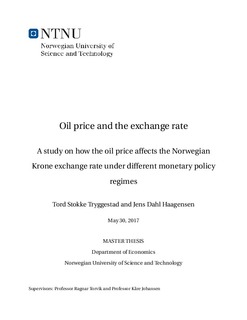| dc.description.abstract | We show the existence of a statistically significant short-term relationship between the Norwegian exchange rate and the oil price, and how this effect increased following the introduction of inflation targeting by Norges bank. Assuming that both the theories of purchasing power parity and uncovered interest parity hold in the long run, we combine the two to form a theoretical equilibrium correction model. By assuming that the expected exchange rate is affected by some real factors, the oil price is included in the model. Emphasizing the role of monetary policy on the oil price effect we split our time period into two, before and after inflation targeting was officially introduced in Norway in 2001. Both ordinary least squares and Markov-switching estimations are performed on a dynamic log-linear model. The latter estimation method proves to be particularly well-performing with near perfect state predictions. As there is evidence of the oil price having asymmetrical effects, the same estimation procedures are performed allowing increasing and decreasing oil prices to have separate effects. We find that the oil price effect did, in fact, increase following the adoption of inflation targeting and that falling oil prices had more to say in this time period than increasing oil prices. In the managed float time period before 2001, the asymmetrical estimations indicate that only increasing oil prices was statistically significant. However, we find less evidence of asymmetrical effects in the this time period, suggesting more symmetrical and smaller oil price effects than under the more flexible inflation targeting monetary policy regime. Long-run solutions is found for all models, but do mostly not contain any statistically significant effects of the oil price or interest rates, implying that the equilibrium exchange rate is decided by the price difference between Norway and the EU. This is especially true in the post-2001 time period, suggesting stronger evidence of the equilibrium exchange rate being determined by purchasing power parity under inflation targeting than under the managed float monetary policy. In the pre-2001 time period, there are some statistically long-run oil price effects, but this could be due to the time-period being relatively short, suggesting that the oil price effects on the exchange rate are, in fact, short term. Although our speed of adjustment coefficient is somewhat low for a rapidly moving variable such as the exchange rate, our estimated half-life of such deviations are lower than those of the general consensus in the literature. | nb_NO |
